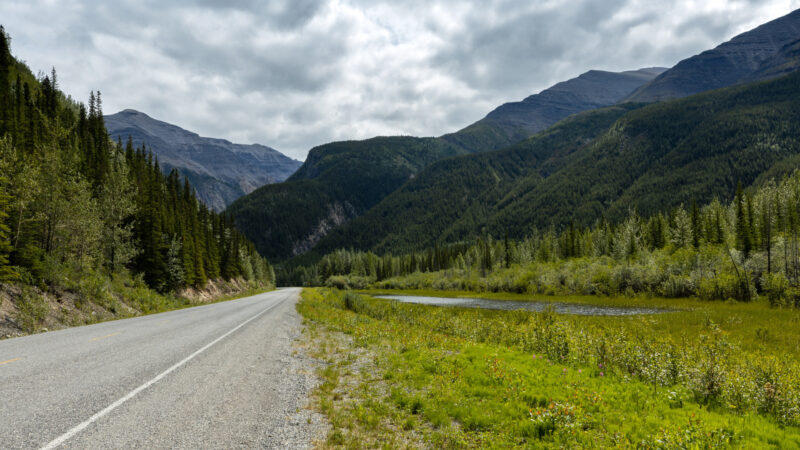Table of Contents Show
A road trip to Alaska is on many RVers’ bucket lists. The mystery and majesty of the Last Frontier beckon travelers worldwide. But it’s a long way from the Lower 48.
If you’re considering a road trip soon, we want to give you some information about the Highway to Alaska — what to expect, where to stop, and what to do. We just made the trip and want to share our experience with you.
Let’s go!
What Is the Highway to Alaska?
The Highway to Alaska, also known as the ALCAN Highway or the Alaskan-Canadian Highway, was built in WWII to connect the Lower 48 with Alaska. But the route doesn’t start in the contiguous U.S. It starts in Dawson Creek, British Columbia, and continues northwest to the Last Frontier.
It was 1,700 miles long upon completion in the 1940s, but the highway is now about 1,387 miles due to construction and rerouting. The British Columbia Highway 97, Yukon Highway 1, and Alaska Route 2 all make up this international highway.
How Long Is the Highway to Alaska?
The Highway to Alaska begins in Dawson Creek, which is near the border of British Columbia and Alberta, Canada. It stretches northwest and runs through Whitehorse, the capital of the Yukon Territory.
From Dawson Creek to Whitehorse is approximately 855 miles. Here Highway 2, also known as the Klondike Highway, intersects with the highway to Alaska.
From Whitehorse, the road continues northwest toward Fairbanks, Alaska. The international border crossing is at mile marker 1,153. It ends at Delta Junction, Alaska, about 95 miles southeast of Fairbanks. Many travelers continue to the city via Highway 2, also known as the Richardson Highway.
Driving the Highway to Alaska without stopping would take 24 hours to cover the 1,387 miles. But the journey offers beautiful overlooks, turquoise lakes, and historical sites worth enjoying along the way. Most people take at least 3 to 4 days to get from one end to the other. Additionally, the speed limits range from 50 to 65 miles per hour.
Can You Drive an RV on the Highway to Alaska?
Unlike remote highways through northern Canada and Alaska (like the Dempster Highway or the Top of the World Highway), the Highway to Alaska is completely paved.
The road conditions are much easier to handle, so RVs should have few problems. Potholes and road construction still exist, but you don’t have to worry about washboard or gravel roads. It’s well-maintained with wide shoulders and no length, height, or width limitations.
Because you’re traveling through international borders, you do need a passport. To reach the southern point of the highway in British Columbia, you’ll need to show your passport at the border crossing wherever you enter Canada from the U.S.
Then you’ll have to show your passport again when crossing into Alaska.

Is the Alaska Highway Open All Year?
The highway to Alaska is open year-round. Commercial trucks travel this road daily, so closing it isn’t an option. However, paying attention to the weather and understanding the road conditions no matter what season you travel is essential.
Your vehicle also needs to be able to handle very low temperatures, as this part of North America routinely experiences -22 degrees Fahrenheit or colder in the winter.
Things to Do Along the Highway to Alaska
When traveling for days along the same highway, you want to have places to stretch your legs. Thankfully, plenty of stops exist to enjoy the outdoors, learn about history and culture, or snap a few selfies along the Alaska Highway.
1. Start in Dawson’s Creek and Take a Selfie
When you start your road trip in Dawson’s Creek, you can take a selfie at the sign at Mile 0. The official origin point sign reads, “You Are Now Entering The World Famous Alaska Highway.” Plus, you can go to the visitor center to get any brochures you might need for the journey.

2. Stretch Your Legs At Muncho Lake
Although you can stop at several places before Muncho Lake, if you want to make good headway on your first travel day, wait to stop at Muncho Lake. It’s about 7.5 hours from Dawson’s Creek.
It has two campgrounds, a few hiking trails, and opportunities for swimming, fishing, kayaking, and boating. You can read about visiting this location in our article “Your Guide to Visiting Muncho Lake.”

3. Take a Dip at Liard River Hot Springs Provincial Park
Less than an hour from Muncho Lake is Liard River Hot Springs, the second-largest hot springs in Canada. You can walk the boardwalk through the swamp and woodland or soak in the Alpha pool for a relaxing afternoon.
Bring cash for the entrance fee. For more info, check out our article “How to Spend Your Day at Liard Hot Springs.”
Pro Tip: Be prepared for your adventures in Alaska and check out our Alaska Packing Guide!
4. Post Your Own Sign at the Famous Sign Post Forest
About 2.5 hours from Liard Hot Springs is the Sign Post Forest. We loved visiting this unique attraction where travelers from around the world post signs paying homage to their hometown.
We brought our own sign, attached it to a post, and then walked through the “forest” to see all the different cities, states, and countries represented. You can read more about our visit in our article “Leave Your Mark at Sign Post Forest.”
5. Learn More About the Tlingit Culture at the Teslin Tlingit Heritage Centre
Crossing through southern Yukon, you’ll arrive at the Teslin Tlingit Heritage Centre about 3 hours after the Sign Post Forest. The center sits on the shores of Teslin Lake.
Inside, you’ll learn more about the Tlingit culture through modern and traditional arts, cultural programming and demonstrations, and a canoe exhibit. However, it’s only open in June, July, and August.
6. Visit the Yukon Beringia Interpretive Centre
Another place to learn about the history of this region along the highway to Alaska is the Yukon Beringia Interpretive Centre. It’s less than 2 hours from Teslin.
This center is dedicated to preserving the prehistoric past with a unique exhibit about Beringia, the land bridge that once connected the Yukon to Siberia.
You’ll learn about the native people who traveled over it and the prehistoric animals that once roamed the land.
Keep in Mind: How Big is Alaska Compared to the USA? Click the link to find out!
7. Go Hiking at Kluane National Park and Reserve
If you have time to make a slight detour, visiting Kluane National Park and Reserve, a UNESCO World Heritage Site, is worth it.
It’s a magnificent park where 17 of the 20 highest peaks in all of Canada stand tall. Hiking trails range from easy to strenuous and take anywhere from 30 minutes to several days to complete.

8. Take a Photo at the Alaska/Canadian Border at Port Alcan
From Kluane National Park and Reserve, the Highway to Alaska turns northwest until it crosses the border at Port Alcan at milepost 1221.
Take a selfie at the “Welcome to Alaska” sign, as you’ve made it 1,175 miles so far! Only a short distance to go before you reach the end of your journey at Delta Junction.
9. Visit the Mainstreet Visitors Center in Tok
From the border, you’ll drive about 1.5 hours before you reach the community of Tok, the “Gateway to Alaska.” Stop in the Mainstreet Visitors Center to stretch and check out everything this region offers.
If you’ll continue your journey through Alaska, this is a great place to get information and ask questions. Tok is also the trade center for several Athabascan Native villages. The local arts and crafts make excellent gifts.
10. Buy a Souvenir at the Smiling Moose Gift Shop at Delta Junction
Finally, when you reach Delta Junction, it’s time to celebrate! You’ve made it to the end of the Alaska Highway. After days of travel, head over to the Smiling Moose Gift Shop to pick up a souvenir.
While walking around, visit the Delta Meat & Sausage Co., where you can find free samples of buffalo and reindeer sausage.
When Is the Best Time to Drive the Alaska Highway?
The Highway to Alaska is open year-round. So as long as you come prepared and know how to traverse this northern highway in snowy conditions, you can drive it any time.
But some attractions and local stopovers won’t be open during the winter. If you want to experience everything along the route, travel it during the summer.
Is a Drive Along the Highway to Alaska Worth It?
The Highway to Alaska is long. There’s no denying that. But if you’re looking for a safe, scenic road from British Columbia to the Last Frontier, this highway is the best option.
Although we only listed 10 places to stop, you’ll find dozens more overlooks, historic sites, and small towns to explore. You could spend a week enjoying the drive.
Do you want to make this trip to the Last Frontier?







You need to mention the abundance of wildlife along the route. We saw 30+ black bears on one trip. You’re almost certain to see big horn sheep, deer, caribou, many others, but be warned, bison sleep on the road near Murdo Lake. Also moose are almost impossible to see if driving after sunset.